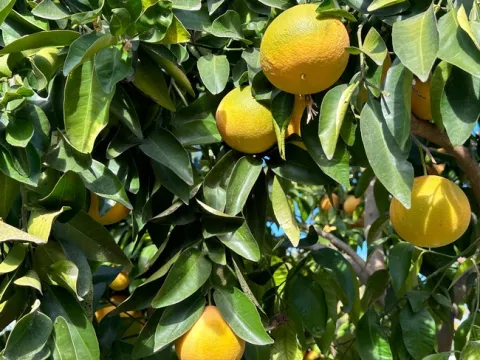
We are fortunate to be able to grow a variety of citrus trees in our area. Because they are subtropical plants, the first consideration is to choose a site that is sunny, warm, and protected from wind in well-drained soil. Most citrus can be grown in pots, but they shouldn't be planted in lawns, because their water and fertilizer requirements are very different from grass.
Watering
Newly planted citrus trees need frequent watering to keep the soil moist; for established trees the top 3-6 inches of soil should be allowed to dry out before watering. Water deeply (4-6” of water) 1-2 times per month, covering the area slightly beyond the drip line and avoiding the trunk. Add 3-4 inches of mulch, keeping it away from the trunk.
Fertilizing
Nitrogen is the main nutrient needed by citrus trees; they should be fertilized each month from May to August, following the package instructions for amounts. If yellowing between the veins on new growth is observed, the tree may need a complete citrus fertilizer with micronutrients iron, zinc, and manganese.
Pruning
Citrus trees respond well to pruning. Suckers, vertical branches, dead or crossing branches, and any that touch the ground should be removed. Opening the center of the tree to light improves yield. The best time for pruning is spring to summer.
Pests
Citrus trees can tolerate some pests without significant damage. Common pests—aphids, whiteflies, scale, and mealybugs—all suck juices from leaves and excrete honeydew, which can lead to sooty mold, a fungus that grows on honeydew. These pests can be managed by controlling ants with sticky material applied to a paper wrap on the trunk. Another preventive measure is to avoid insecticide use and to plant flowering plants nearby to encourage predatory and parasitic insects that control pests.
A major concern is a bacterial citrus greening disease—Huanglongbing or HLB—caused by infected Asian citrus psyllids (ACP), which has the potential to decimate entire orchards.

An early symptom of HLB is the yellowing of leaves on an individual limb or in a sector of a tree's canopy. Disease symptoms also include twig dieback, yellow leaf veins, and green misshapen fruit. The California Department of Food and Agriculture (CDFA) has instituted a monitoring program and has set up a hotline at 1-800-491-1899 for residents to report suspicious insects or disease symptoms in their citrus trees.
Frost:
While San Joaquin County has a climate favorable to growing citrus, frost can be an issue. In general, when temperatures fall to 29 degrees F for 30 minutes or longer, some frost damage to citrus plants will occur, with the extent of the damage depending on the type of citrus. Grapefruit and orange trees have a medium sensitivity to frost; lemons and limes are more highly sensitive.
One way to minimize frost damage is to be sure the trees are well watered before a cold snap. Pruning and applications of fertilizer stimulate new growth, which is more susceptible to frost, so these activities should be done in the spring and early summer. If a severe frost is predicted, a 100-watt outdoor lamp placed in the interior of the tree will reduce frost damage.
Harvesting:
Don't worry if your tree drops young fruit—this is normal. Many varieties also alternate between heavy and light bearing years. For the best flavor, fruit should be left on the tree until it is fully ripe, because it will not continue to ripen after it is picked. A taste test is the way to determine this, so you can best enjoy your delicious crop!
For more information:
Frost Protection for Citrus and other Subtropicals.
https://anrcatalog.ucanr.edu/pdf/8100.pdf
Deadly Citrus Greening Disease: A Better Lure for Asian Citrus Psyllids.
https://ucanr.edu/blogs/blogcore/postdetail.cfm?postnum=3162
Growing Fabulous Citrus. https://ucanr.edu/sites/mgscc2016/files/319461.pdf

